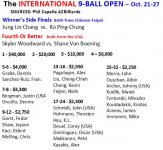I used to do the prize money structures for Barry. It could have looked like this:
1. 40,000 2. 20,000 3. 10,000 4. 8,000 5-6. 6,000 7-8. 4,500 9-12. 3,000
13-16. 2,500 17-24. 2,000 25-32. 1,500 That also adds up to $149,000.
If you add in the missing $13,000 then it would have looked quite a bit better!
Yes, this is a pretty strange payout structure, but pool has no standardization when it comes to this.
Contrastingly, PGA golf has a defined payment structure in which, if memory serves, the winner always gets 18% of the purse, second always gets 10.8%, etc., all the way down to a predefined payout to the lowest finishing player that made the cut). This kind of standardization is very desirable.
Without a pro tour having a governing body, though, event producers can pay out as they please, and there really are no published guidelines for payouts. The big events in America are all independent these days, a sign of the times and not, by any measure, a good sign.
Usually, I can look at a payout structure and call it either top-heavy or bottom-heavy, but this payout structure was, most improbably, both!
The guys who reached the final day all had solid paydays, and that's how I like it. Top-heavy prize funds always rub me the right way.
I'm sure the guys who came 25/32 were quite happy with how much they got, but the payout for cashing, relative to the prize fund, was way too high for my taste, making the prize structure bottom-heavy. No doubt, the objective was to make it so that anyone cashing would cover all expenses relating to their participation in the event, a noble idea that just doesn't make sense with a prize fund this small. The benefit, though, is likely greater international participation, meaning a more elite field.
Where this payout structure failed most was in being super-light in the middle. The monetary value of wins in the middle stages of the event was way too low, and I'm sure this rubbed many of the players the wrong way.
In the absence of guidelines (and historical precedent is not binding in any way at all), independent event producers can, and should, pay out in any way that they feel will help their event grow.
... but this payout structure didn't work for either of us, Jay.

